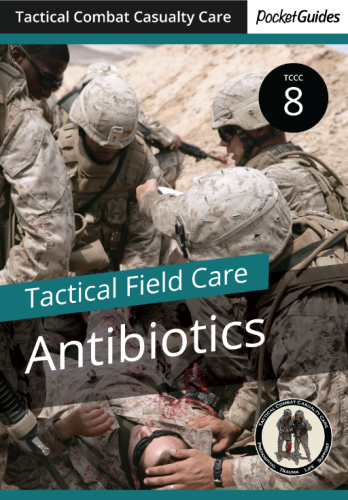Support the development of the TCCC project in Ukraine
8. TFC Antibiotics
Introduction
After completing the Pain portion of Tactical Field Care, the next focus is on Antibiotics.
In this module, we will discuss the use of antibiotics appropriate for the Tactical Field Care phase of TCCC. In general, antibiotics are given as soon as possible for all open wounds.
Objectives
Video: Tactical Field Car: Antibiotics.
Guidelines and Key Points
Antibiotics
Recommended for all open combat wounds:
- If able to take PO medications:
- Moxifloxacin, 400 mg PO once a day
- If unable to take PO medications (shock, unconsciousness):
- Ertapenem, 1 g IV/IM once a day
- Antibiotics Key Points
Moxifloxacin is broad spectrum and kills most bacteria. It has few side effects. Give as soon as possible after life-threatening conditions have been addressed. Delays in antibiotic administration increase the risk of wound infections.
- IM ertapenem should be diluted with lidocaine (1 gm vial ertapenem with 3.2cc lidocaine without epinephrine).
- IM- administer into a deep muscle mass (gluteal, lateral thigh).
- IM-use within 1 hour after preparation.
- IV requires a 30-minute infusion time.
The Combat Wound Medication Pack contains the following components:
- Moxifloxacin 400 mg one tablet (one),
- Meloxicam 15 mg one tablet (one),
- and Acetaminophen 1300 mg extended release, (2) 650 mg caplets.
These meds should be carried by EVERYONE in the unit and self-administered as soon as possible after sustaining a wound.
Screen your units for drug allergies!
Patients with allergies to aspirin or other non-steroidal anti-inflammatory drugs should not use Mobic.
Patients with allergies to fluoroquinolones, penicillins, or cephalosporins may need alternate antibiotics which should be selected by unit medical personnel during the pre-deployment phase.
Check with your unit physician if unsure.
Summary:
Antibiotics are recommended for all open combat wounds.
Moxifloxacin if able to take PO.
Ertapenem if unable to take PO.
Give antibiotics as soon as possible for all open wounds.
Antibiotics in TCCC 2002
Antibiotics in Tactical Combat Casualty Care 2002
MAJ Kevin O'Connor, MC USA; CAPT Frank Butler, MC USN
Military Medicine. 168. 11:911. 2003
- Description with Key Points
Care of casualties in the tactical combat environment should include the use of prophylactic antibiotics for all open wounds. This article recommends that oral gatifloxacin should be the antibiotic of choice because of its ease of carriage and administration, excellent spectrum of action and relatively mild side effect profile. Moxifloxacin and gatifloxacin are both fourth-generation fluoroquinolones that have an enhanced spectrum of activity and are given as a single daily 400-mg dose. Based on their similarities, either moxifloxacin or gatifloxacin would be a good choice for an oral antibiotic to use on the battlefield. Since gatifloxacin was removed from the market by the FDA in 2008, moxifloxacin is the oral antibiotic of choice for battlefield casualties with open wounds.
For those casualties unable to take oral antibiotics because of unconsciousness, penetrating abdominal trauma, or shock, intravenous cefotetan is recommended because of its longer duration of action than cefoxitin. Whereas cefoxitin and cefotetan appear to be equal in efficacy, the longer half-life and comparable cost make cefotetan a better choice for use by combat corpsmen and medics. Cefoxitin remains a viable alternative and a good second choice.
Antibiotics in Tactical Combat Casualty Care 2002

Take Home Message:
Prophylactic antibiotics should be used by combat medical personnel for all open combat wounds.
Where there is no contraindication to the use of oral antibiotics, give moxifloxacin 400 mg. by mouth once a day.
Moxifloxacin is a broad-spectrum antibiotic that kills most bacteria and has few side effects.
Delays in antibiotic administration increase the risk of wound infections.
If unable to take oral medications (shock, unconscious, or penetrating abdominal injury), this article recommends cefotetan. 2 gm intravenously (slow push over 3-5 minutes) or intramuscularly every 12 hours.
NOTE: Cefotetan has been difficult to obtain through supply channels, resulting in the recommendation of Ertapenem 1 gm IV/IM once a day by the TCCC community.
TCCC in Operation Iraqi Freedom
Tactical Combat Casualty Care in Operation Iraqi Freedom
CPT Michael J. Tarpey, MC, USA
Army Medical Department Journal, 2005, PB 8-05-4/5/6 Apr/May/Jun
- Description with Key Points
At the time this article was written, the Tactical Combat Casualty Care (TCCC) guidelines had been widely practiced with excellent results throughout the Special Operations community. However, there had been very little spread of the use of the TCCC guidelines into conventional units. This article reviews the use of the principles of TCCC by a mechanized infantry unit in Operation Iraqi Freedom1 One (OIF I).
Antibiotics were administered to all casualties with open wounds, even relatively minor fragmentation wounds. None of the casualties developed wound infections. The exact antibiotics recommended in the TCCC guidelines could not be obtained, but suitable alternatives were found. Soldiers who could take oral medicines received Levofloxacin, which was convenient due to its once daily dosing. Those wounded who could not take medicines orally received IV Cefazolin for extremity wounds and lV Ceftriaxone for abdominal injuries.
Tactical Combat Casualty Care in Operation Iraqi Freedom

Take Home Message:
The adoption and implementation of the principles of TCCC by a medical platoon in OIF l resulted in overwhelming success.
Over 25 days of continuous combat with 32 friendly casualties, many of them serious, we had 0 KlAs and 0 died from wounds, while simultaneously caring for a significant number of Iraqi civilian and military casualties.
This success should serve as a model for other conventional combat units throughout the Army involved in Level I treatment.
The principles of TCCC are well-researched and proven effective and should be the foundation for the treatment of battlefield casualties.
32 casualties with open wounds, all received battlefield antibiotics, none developed wound infections.
Used TCCC recommendations modified by availability: Levofloxacin for an oral antibiotic, IV cefazolin for extremity injuries, IV ceftriaxone for abdominal injuries.
You can discuss this material on the TCCC forum



















